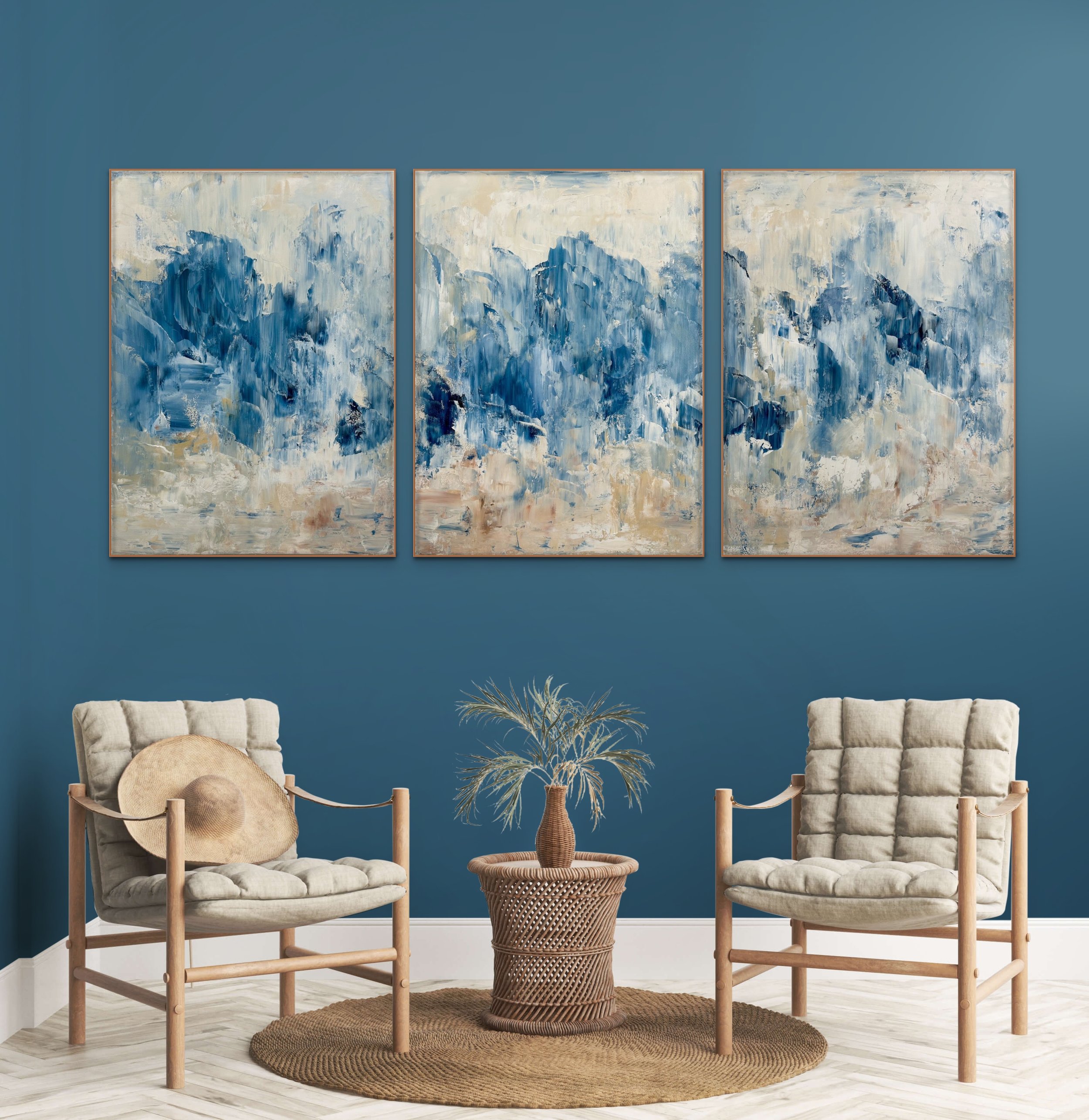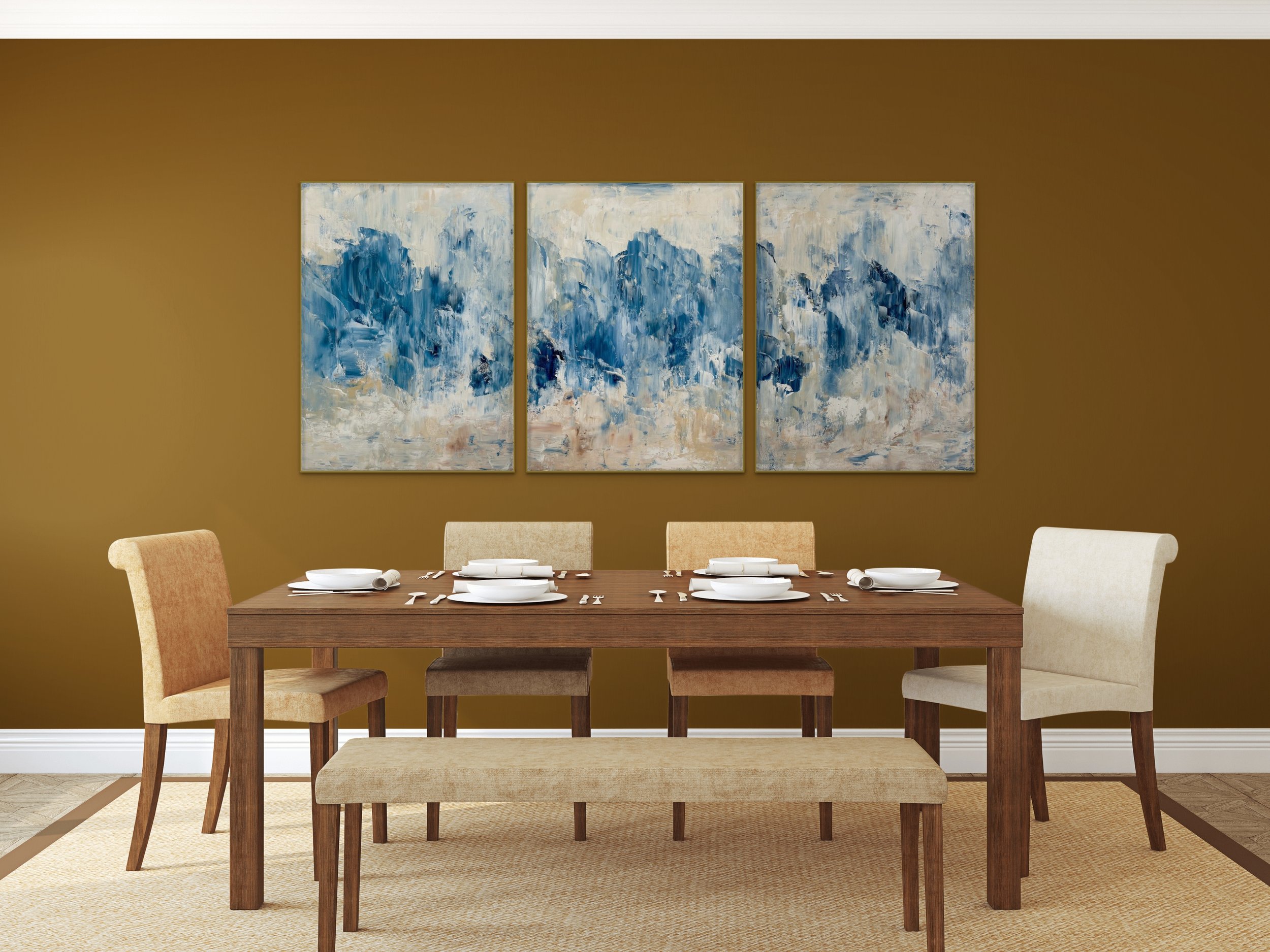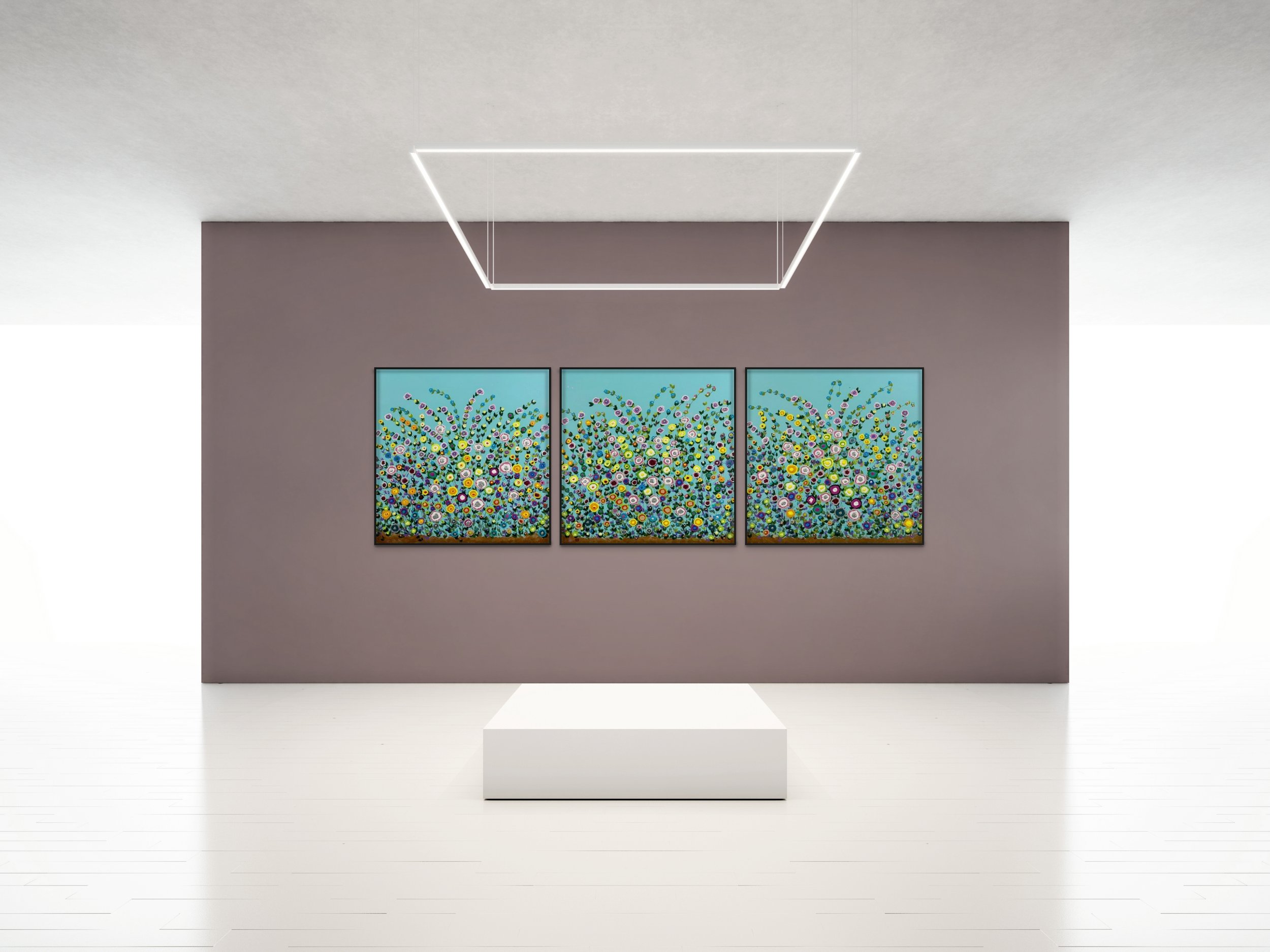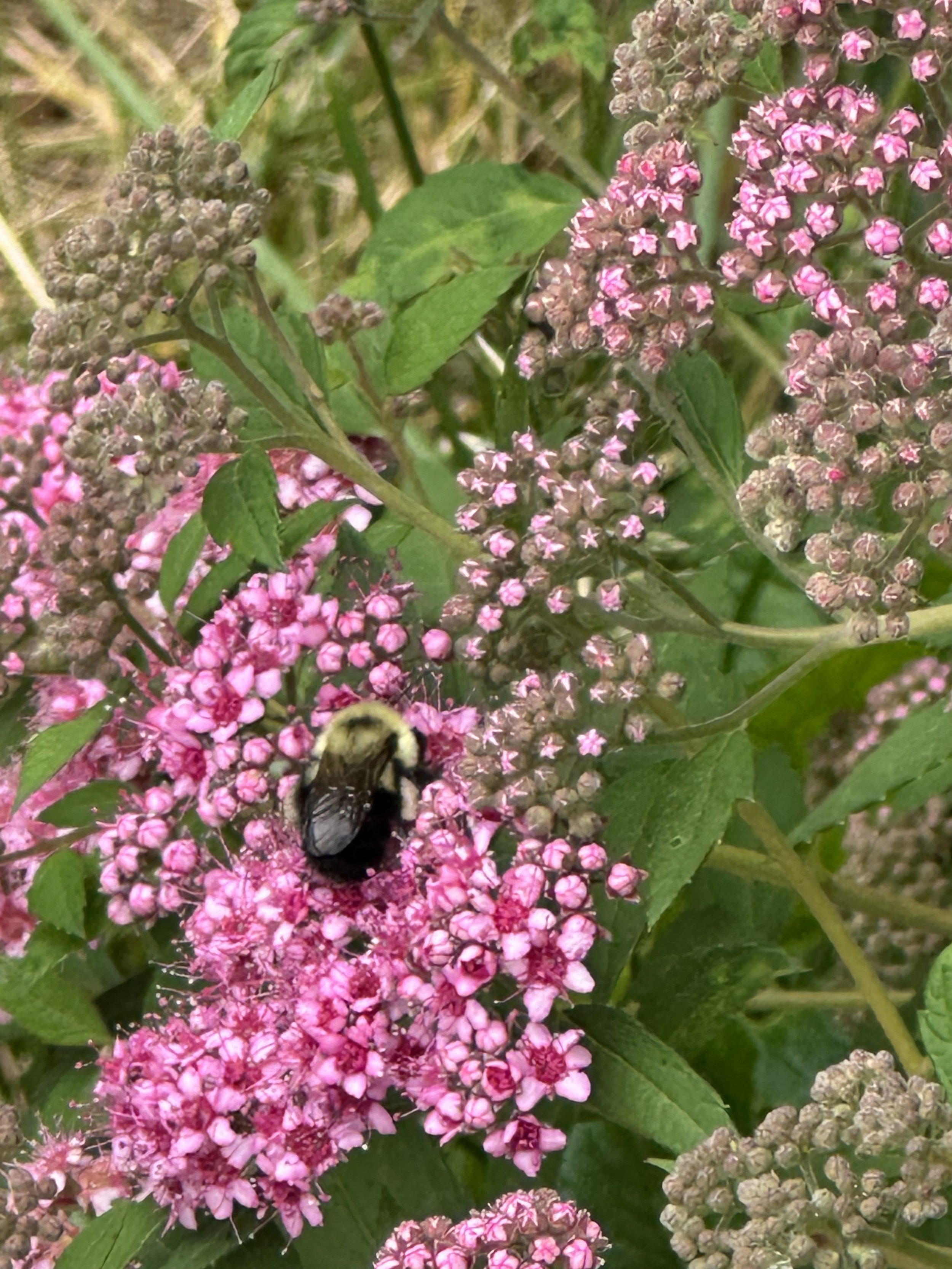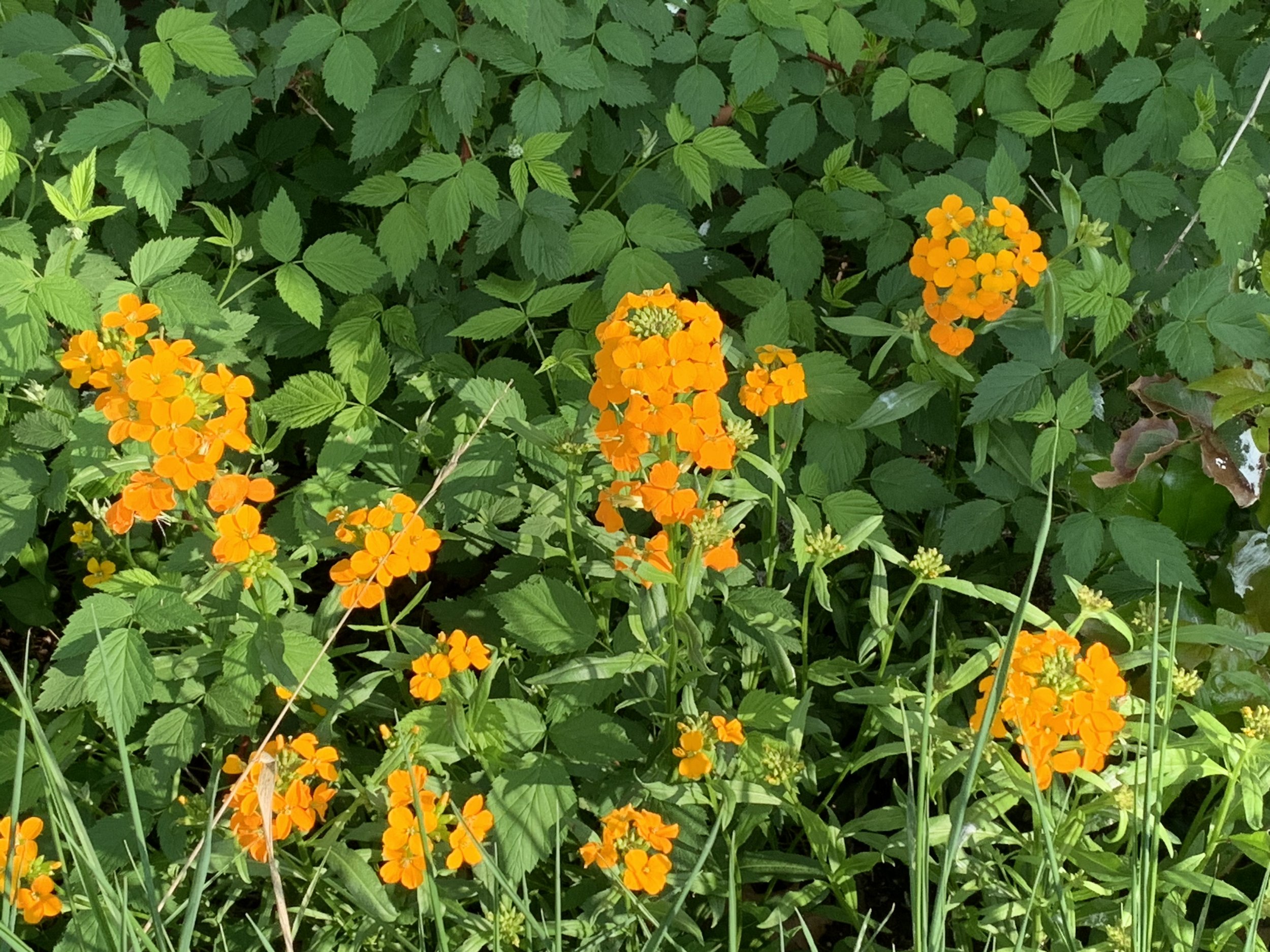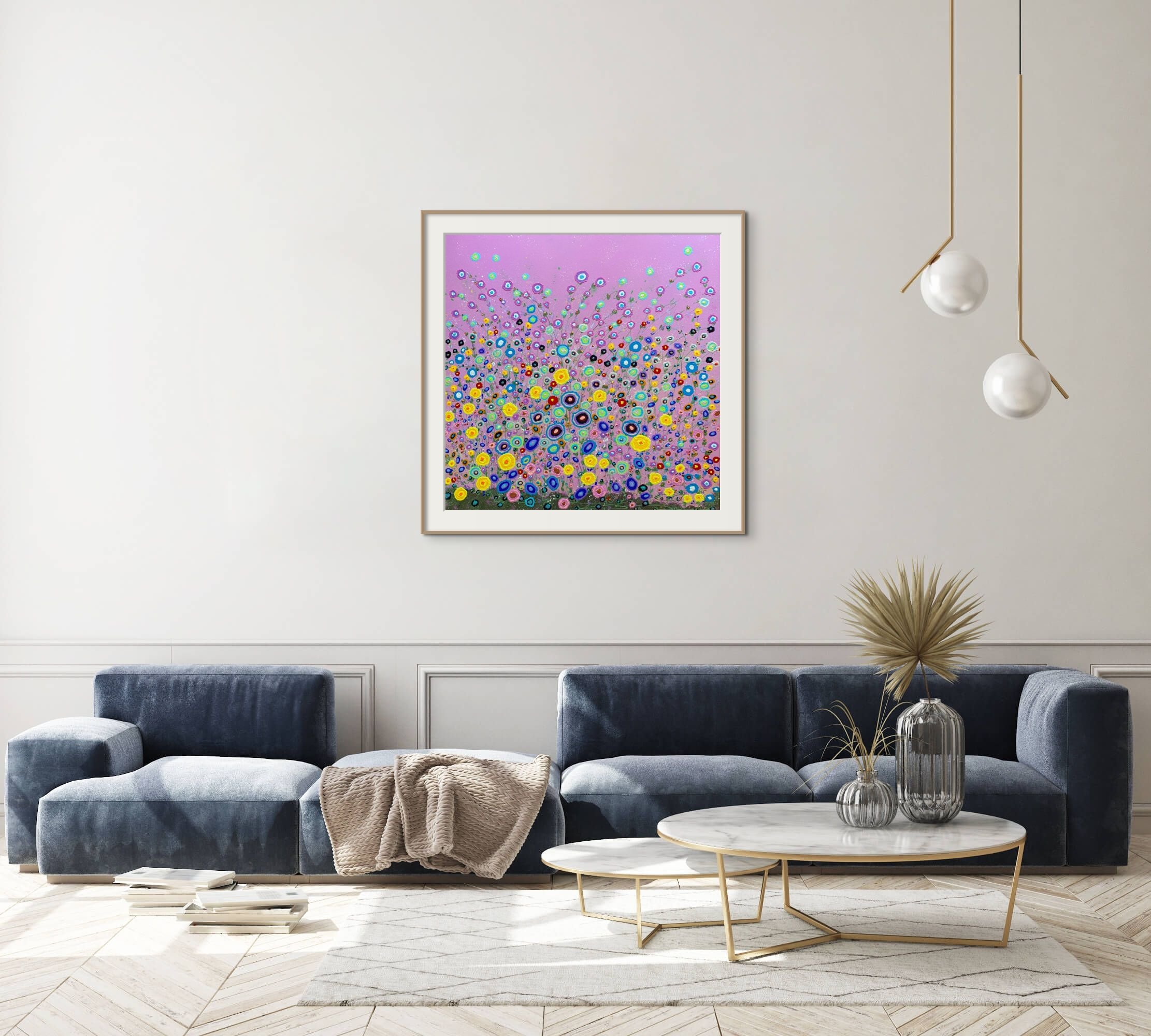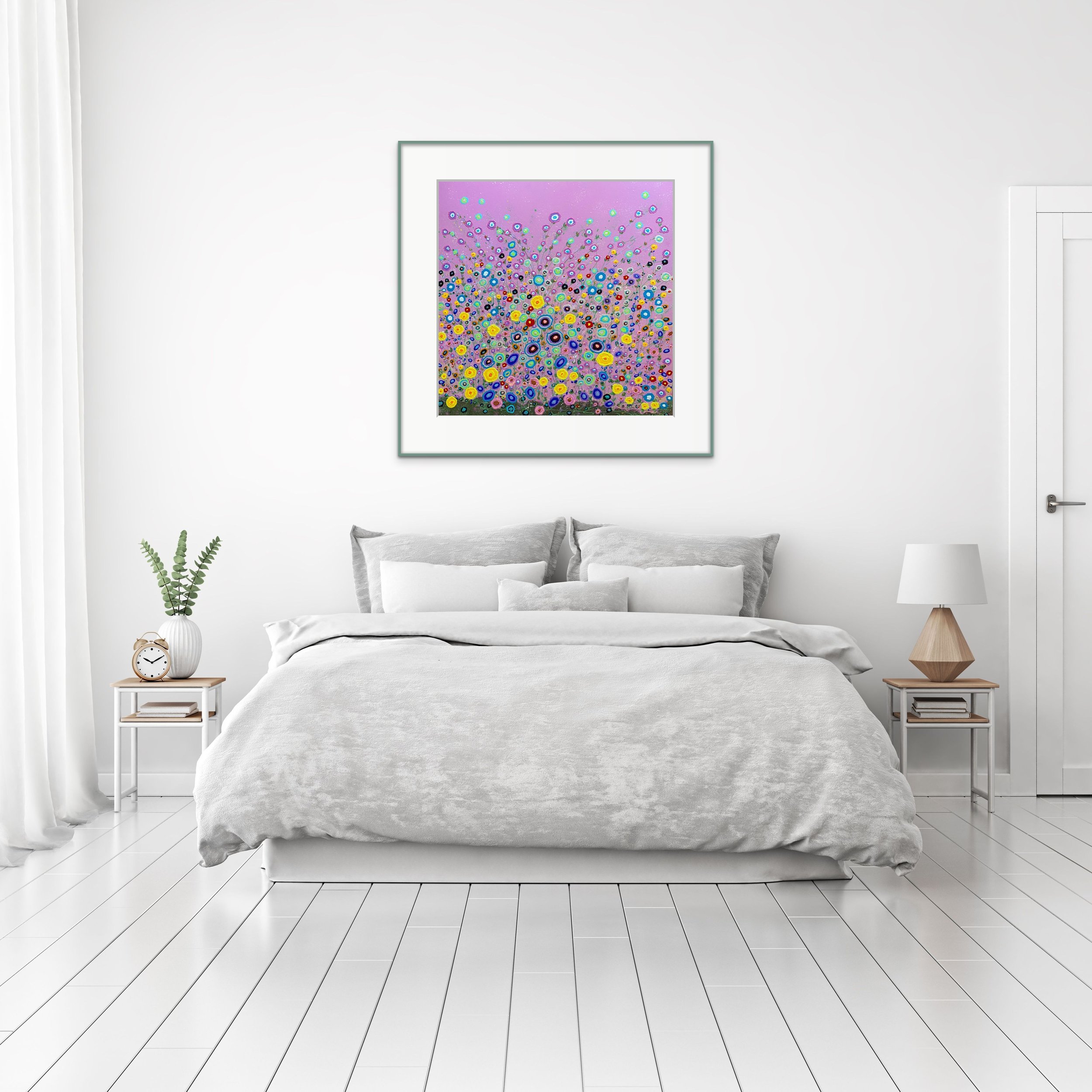At The Heart Of My Evidence-Based Design Art
Art marketing experts and advisors have been telling me for years that I need to pick one art category and paint in it.
I tried to stay in one art category, figuring that my sales figures would eventually show me the right direction to take, but then I kept selling and selling in all of my categories.
Next, I thought I’d find my one big winning category when my art got viewed by art curators from around the world. If you look at my dorotheasandraart.com website’s first page and scroll down to the 2025 International Curations, you’ll laugh. I haven’t posted them all, but right now, I am in 44 different international art curations—and the art curators seem to like my art in all the different categories and styles I paint.
Thankfully, it was my evidence-based design knowledge and training that eventually helped me understand that I really do have one central item running through all of my art:
I discovered that—whether it’s a painting about sustainability, an evidence-based design floral impressionism, a water-inspired movement composition, or even an intense abstract—AT THE HEART of every single one of my paintings are elements of LOVE and CARE.
If the inside of my art could speak, it would say, “In this painting is love and caring about human health and happiness.”
The Happiness Factor by Dorothea Sandra, EDAC, 5’x8’
















Using my Evidence-Based Design Certification (EDAC) training, the colors are bright, cheerful, and welcoming. Viewers can see through the stems, which scientific studies have shown to create safety in human minds. Flowers rooted in soil suggest a continuation of life, unlike cut flowers in a vase, which will soon die. The yellow sun, with its healthy-looking morning glow, gives many viewers the feeling that “survival” will be easy, which creates chemicals in the brain (like dopamine) that make humans feel happiness.
At the heart of this painting is a deep care for human health and happiness.
Happy Sustainable Memories by Dorothea Sandra, EDAC, 5’x8’
This next painting, Happy Sustainable Memories, is an entirely different style of art, but at its heart—like in The Happiness Factor—is a sincere caring about human health and happiness.
In evidence-based design and art, local scenery is often suggested as a composition. Instead of focusing on a snapshot of a local scene, I chose in this painting to take in an entire journey within a local area and represent it through art.
The composition was inspired by nature and a trip from Pasadena, California, along the super busy Foothill Freeway on my way into the desert area near Palm Springs. In this painting, I chose the cheerful colors of yellow, muted pink, and orange to represent the mountains. There is an abundance of sand in the desert, so I used Liquitex’s professional-level unbleached titanium/beige (with a touch of gold) color for the painting’s sky and background. In evidence-based design, you don’t need to portray everything realistically; for instance, creating a blue sky isn't always necessary.
For people/patients who know the area, this painting—in a fun and happy abstract/expressionism/impressionism style—reassures and comforts and recenters them by visually connecting them to their nature-filled and sustainable beautiful local scenery.








This next style of art—where many of my SMART CITY ART series abstract paintings were featured at the 2025 SRI Sustainability Research and Innovation International Congress in Chicago—radically differs from most of what I do.
At first, I was confused and thought, “Here I go again, taking off into yet another different direction.” It took some time, and again, I believe my evidence-based design training and certification helped me understand that underneath even these abstract paintings was this same caring and love for human health and happiness.
My SMART CITY ART abstract series is about caring about human health and happiness, not just individually, but collectively within communities.
Each painting has a smart city technology and sustainability message and a fun, happy, modern flow. In addition, embedded within each painting’s composition are smart city technology and sustainability symbols and iconography.
The paintings include scientifically acknowledged elements that lead to improved human health and happiness: nature-based solutions, blue areas, 15-minute walkability, financial equity, governance, and so much more.
My art at the 2025 SRI Sustainability Research and Innovation International Congress in Chicago, USA.
Smart City Green, Smart City Equity, and Smart City Collaboration
Pretty City Art
Dynamic Cities Of The Future
Even within these dark and ominous paintings below, I realized that my love and care for human health and happiness was still the motivation at the bottom/heart/soul of all of my art. It was the energy behind everything that gave all of my paintings life.
In Middle Class Anger, I was concerned for human health and happiness as I watched the U.S. middle class lose economic stability and standing. In Chaos Enjoying Power, which was created about a month before the first “NO KINGS” rally even occurred, I was worried that power in chaotic hands would harm people and reduce human health and happiness.
Middle Class Anger
Chaos Enjoying Power
With my floral impressionism art featured on the 2025 cover of Healthcare Design magazine, all the way to this dark and sinister abstract art video below from Opulent Art in London, it seems as if my art is all over the place—but it isn’t.
The message is always the same: A care of human health and happiness is what my paintings are all about!
(In the video, starting around 2:30 minutes, Chaos Enjoying Power holds a premium place.)
Scientists, Researchers, And Art
I get told—all the time—how my art is beautiful and how happy it makes people feel. This is true, but there’s a deeper story here.
Hidden away from the public, and often in research labs and scientific facilities, are the many people who have dedicated themselves to the study of human health and happiness. They are doctors, researchers, scientists, and more, and I like to read their research results and then transition what I have read into a work of art.
I don’t mind taking credit for being a talented artist, but I never forget all the hours and days and years of intelligent scientific thought and methodology that went into the medical and scientific study results that I read and then use inside my art.
I also like to experiment. Here’s my latest painting using many evidence (research)-based design strategies and suggestions.
In evidence-based design and art, local scenery is often suggested. Instead of focusing on a snapshot of a local scene, I chose to take in an entire journey within a local area and represent it through art.
This painting was inspired by nature and a trip I took from Pasadena, California, along the super busy Foothill Freeway on my way into the desert area near Palm Springs.
To be exact, in Pasadena, I got on the 210 Foothill Freeway, with the thickly wooded and dark green San Bernardino Forest on my left. As the highway transitioned to US Interstate 10, it started raining, and suddenly, 10 lanes of headlights came on. It was bumper-to-bumper and stop-and-go traffic for a while, and then the rain stopped and the traffic eased up as I entered the California desert area. Still on Interstate 10, I could see Mt. San Jacinto and then the Santa Rosa and San Jacinto mountains in the distance.
In this painting, I chose the cheerful colors of yellow, muted pink, and orange to represent the mountains.
There is an abundance of sand in the desert, so I used Liquitex’s professional-level unbleached titanium/beige (with a touch of gold) color for the painting’s sky and background.
In evidence-based design, you don’t have to represent everything realistically: for example, you don't always have to create a blue sky.
Every two years, the Center for Health Design requires its certified members to take additional evidence-based design courses in order to recertify. This year, one of my selected CEU courses was The Changemaker-A Pioneer Connecting Art, Medicine, and the Advancement of Evidence-based Design. This course was about Dr. Henry Domke, a physician and photographer. For over 20 years, Dr. Domke practiced as a family physician, which gave him firsthand insight into the stress and anxiety experienced by patients and their families in medical facilities. His healing intent is to use art to create a "healing tone" that provides comfort, reduces stress, and offers positive distractions for patients, staff, and visitors.
Something he said in the video—and I agree with and use all the time in my art—is that an evidence-based design’s composition and focus should not be about the artist. When I paint, it’s not about my ego or my self-glorification. An evidence-based design composition should be created with the patient's needs in mind.
Happy Sustainable Melodies was created as a fun, almost whimsical work of art that reflects a local scenery adventure. With its bright, happy colors, playful stem arrangements, and splashes of green impressionist flowers, it’s also a happy distraction piece.
The brilliant blue color was used to represent a gap between leaving the 210 Foothill Freeway, with its deeper dark colors and thickly populated area, and entering the openness of the desert.
The darkness at the bottom of the painting represents beginning this artistic local scenery journey at the deep-colored and green San Bernardino Forest area. The many plant stems going in many winding and different directions reflect the lanes and lanes of traffic coming in and out, as I traveled on these highways. Midway in the painting, the various colors leading to the desert area show how the scenery transitions from one type of landscape to another.
For people/patients who know the area, this painting—in a fun and happy abstract/expressionism/impressionism style—reassures and comforts and recenters them by visually connecting them to their nature-filled and sustainable beautiful local scenery.
And most importantly, this painting never would have been created this way—at least not by me—without all the hard work and loving dedication of doctors, researchers, scientists, and more.
Different Types Of Evidence-Based Design
There’s Evidence-based Design, and then there’s NOT Evidence-based Design.
Here are a few evidence-based design art guidelines. Many of these guidelines come from “A Guide to Evidence-based Art” from The Center For Health Design, research by Ulrich and Gilpin, a case study on best practices in evidence-based design by the Mays Clinic at the MD Anderson Cancer Center, and so much more.
Landscapes
They can be regional, generic, or seasonal. They should have visual depth or open foreground. Trees should have a broad canopy. Savannah and park-like landscapes are preferred by many. Vegetation should be lush. Empty park benches and sunsets should be avoided. The empty park bench might remind someone of loss and loneliness. A sunset might represent the end of life.
Florals
Florals should include familiar shapes of plants and flowers. They should appear healthy and fresh, and flower colors should be vibrant. Gardens and bouquet styles are acceptable. Flowers in vases should be used sparingly and only for variety.
Taking scientific or medical study results and turning them into artistic creations is not the easiest thing to do. There are no step-by-step guides to follow, and the rules need to be there, but sometimes they need a little bending.
The painting above, Healing Flowers, spent time on exhibit in a museum and then in a gallery. It recently sold, in 2025, to an art collector in Fort Worth, Texas. Also, in Jan/Feb 2025, it was featured on the cover of Healthcare Design Magazine. In addition, in 2024, I was also asked to show it in another issue of Healthcare Design Magazine issue. On one international art gallery website, this painting received thousands of views.
While creating it, I tried to adhere to the evidence-based landscape design guidelines for healthy outcomes. By following the rules, I figured I could trigger the brain to create dopamine, which would produce in its viewers feelings of happiness.
If you look closely, you can see through the stems, which gives viewers visual depth. According to the research, seeing through the stems helps humans feel safe. It takes us back to our days of hunting on the Savannah, where dangerous animals could hide in thick grass and then attack us. While the stems were thin, I ensured the flowers appeared lush and abundant. Again, this would suggest an abundance of food.
Healing Abundance by Dorothea Sandra, EDAC
Using the same evidence-based design guidelines, Healing Abundance also sold in early 2025. It was sold from a gallery in Paris, France, and shipped to a company in Hong Kong with television channels in Hong Kong, mainland China, Macau, and other Chinese-speaking areas. The soil and stems are there, but I wanted to add lush vegetation through the flowers.
Years ago, when I was living in Asia, a good friend who was also a medical doctor ended up in the hospital. I went to visit her with a bouquet of cut flowers in hand. After she got out of the hospital, she told me that a bouquet of flowers was not the best gift. A potted plant would have been more appropriate. When I asked why, she explained that cut flowers will soon die, while a plant in soil continues to live on.
Most everything I do in the creation of an evidence-based design painting is for the health and happiness of viewers.
Why Did I Become Evidence-Based Design Certified?
A couple of years ago, I was on a very popular—and seemingly legitimate—New York City art website that was promoting art for health and healing.
Get this—misshapen and horrifically disfigured images; spread open naked human legs and rolls of unhealthy body fat; abstracts of daggers and dripping blood—all amazing works in their categories—just nothing I would consider appropriate for the elimination of stress or the recovery of human health.
This set me on a course for knowledge. I wanted to discover if I could actually learn to design/create with your health and healing in mind. I found The Center For Health Design with its excellent EDAC (Evidence-based Design) courses and certification. Imagine thousands of doctors, hospital administrators, health facility architects, hospital room designers, and many more professionals worldwide basing their creative/artistic decisions and designs on actual medical studies.
Instead of some untrained art critic or consultant setting the standards for art, health, and healing, I now had real medical professionals to learn from and follow. The EDAC exam was the most challenging test I ever took (and I’m a university graduate with high grades), but the knowledge I gained—which I now incorporate into my designs—was absolutely worth all the hard work.
It’s amazing how many people who buy my evidence-based designs tell me how this “evidence-based” art actually shifts their moods and creates positive and uplifting feelings/states of mind.
Here are four examples of what should never be promoted as evidence-based art for health and healing. Two of the pieces sold within minutes to a collector. They had merit, just not as evidence-based design art.
The first painting is titled Anguish and is part of a series I created about child abuse. This painting artistically reflects the mental and emotional suffering that children experience when they are not nurtured in healthy ways.
The second work, Killed Opportunities, shows how barren and tragic a child’s life becomes as opportunities for health and happiness are killed.
The third painting, Death By Power, reflects negative power winning. The face of a hideous creature looking at the viewer (top center) and a hand with the middle finger raised up (lower center) are perceptible.
In February 2025, I sold The Tempest, the fourth painting, again to a collector.
All four paintings have merit as works of abstract art. The art itself, however, does not de-stress or promote health and healing. In fact, it does the opposite.
Can you imagine the added stress and trauma of looking at any one of these paintings while recovering in a hospital bed? Before training to become evidence-based design certified, I wondered why influential people in the art world were calling paintings like this art for health and art for healing. It just didn’t make any sense to me.
Here are more beautiful paintings that would not be considered 100% appropriate evidence-based designs. Some I sold, some are for sale through a Paris, France international gallery, my website, Galleri Soho in Sweden, and more.
When I create evidence-based design art, I use design suggestions and strategies based on credible scientific and medical research. I get my information from a variety of sources, but I enjoy and value the trainings (which are required for EDAC recertification) at the Center For Health Design and their journals and repository information.
There’s a difference between pretty art that makes us feel happy and art that triggers our brains to feel happy based on medical and scientific research. Evidence-based design is that kind of art.
Is Evidence-Based Design Totally New?
Is Evidence-Design Totally New?
If you asked the 6th BCE Greeks of Epidaurus, they might take you to one of the most celebrated healing centers of the classical world—the Asclepieion hospital. In their hospital, patient rooms faced eastward. Why? It is believed the rooms were intuitively designed and placed toward the sun to promote healing.
Many centuries later, many movements from different countries came together in the 1970s to create a new field called evidence-based design.
Who are the people whose forces created this new discipline? Doctors, Scientists, Architects, Interior Designers, Psychologists, Sociologists, Anthropologists, and many others.
The Healing Window by Dorothea Sandra, EDAC, 36”x48”
This artist’s journey into Evidence-Based Design
Photo from the back of McLaren Northern Hospital, Petoskey, Michigan
I am known by many titles in the art world: Artist Of Happiness; a modernizer of traditional woodland compositions; a Great Lakes artist; a 21st-century experimental artist; creator of the evidence-based design collection, Symphonies Of Love; creator of the Smart City Art Collection; and more.
At the beginning of my evidence-based design artistic journey, I chose to create a painting depicting a view from a hospital room. The background of The Healing Window features Little Traverse Bay, as seen from the back parking lot of McLaren Northern Hospital in Petoskey, Michigan.
While composing this painting, I imagined myself in one of the patient rooms at McLaren Northern, looking out the window.
I also imagined myself in a patient room or in a healthcare lobby or a waiting area.




Artists always have lots of choices to make. Early in my evidence-based design floral art career, I chose creating happiness (triggering dopamine) over painting realism. My reason? I figured I would have more power to create happiness if I had more artistic power of the flowers. Not only did realism limit my ability to create happiness (dopamine), but according to medical and scientific research, traditional still-life wasn’t an art category most favored within evidence-based design.
So, is evidence-based design totally new? Yes and no. The flowers in this artwork are modern, cheerful, uplifting, and based on current evidence-based design best practices. However, I also wanted to pay homage to the accomplishments of those who came before us by incorporating elements that, especially in the design texture of the vases, evoke a rough, ancient Greek Asclepieion aesthetic.
Inside Evidence-Based Design Art
I do not have the expertise of a neuroscientist or medical researcher or practitioner, but I do LOVE to study their evidence-based design results and find ways to experiment with them in art.
In Symphonies Of Love Number 11 my goal was to create a beautiful work of art without much impact.
To create the beauty, I chose the shape of a heart because I wanted a very clear, strong message that instantly communicated, “You are loved.” I find too much evidence-based design art today a little too wispy and without form. Sometimes people, and especially children, need a clear, up-in-your-face message, especially one of love.
Can you imagine a child in a patient bed or waiting area? Fear, worry, doubt can be big factors within a healthcare setting. I think an image of a heart outperforms a typical biophilic design when it comes to encouraging feelings of love, safety, and care.
Also for this painting, I chose to blend the inner area of each flower mostly with each flower’s petal color. What this does is create beauty without impact/stress, something super valuable within many healthcare environment locations. Some people are at the outer limits of their emotions in this setting, so creating beautiful art that does not stress is often welcome and greatly appreciated.
Take a look inside my book, 100 Days Of Happy Happy Art, Evidence-Based Design.
There’s even a chapter on neuroscience and art.
Inside Evidence-Based Design Art
If you walked past this painting in a healthcare hallway, would your brain receive a message of love without being overly impacted or stressed by the art?
I do not have the expertise of a neuroscientist or medical researcher or practitioner, but I do LOVE to study their evidence-based design results and find ways to experiment with them in art.
Symphonies Of Love Number 12 by Dorothea Sandra, EDAC
This painting was strategically and deliberately designed using evidence-based design principles and guidelines.
My first goal for this painting was to create a soothing, stress-free background. A large body of research is consistent with the proposition that humans are hard-wired to appreciate and benefit from exposure to nature. I chose the color green for the background because green gardens and parklike settings are acceptable in evidence-based design. I could have added some dabs or splatters to the background, but I decided a super smooth, flat background would create beauty without impact or stress.
My next goal was to decide on a composition. I chose the shape of a heart because I wanted to very clearly and very powerfully create a message that said, “You are loved.” I find too much evidence-based design art today wispy and without form. I think those designs are truly wonderful and quite celebratory of nature, but sometimes humans—especially children—need a clear, up-in-your-face message, especially of love.
Can you imagine a child in this patient bed? I think an image of a heart outperforms a typical biophilic design when it comes to encouraging feelings of love, safety, and care.
My third goal for this painting was to add some fine art flair. Nationally and internationally, people have begun to recognize my signature style of making flowers and they like them. As I am forming the flowers, I use a variety of art techniques to build in and create feelings of happiness and joy.
Keeping with my evidence-based design goal of beauty without impact, I very minimally added a pistil tip to each flower.
If you walked past this painting in a healthcare hallway, would your brain receive a message of love without being impacted or stressed by the art?
Did You Know This About Health And Art?
Did you know that Evidence-Based Design nature scenes are restorative?
Did you know that Evidence-Based Design nature scenes are restorative?
With all the talk today about Evidence-Based Design—what is it?
Evidence-Based Design is a field of study that emphasizes using credible medical and scientific evidence to influence design. Evidence-Based Design uses ideas from environmental psychology, architecture, neuroscience, behavioral economics, and more.
According to Ulrich and Gilpin, research suggests that nature art, or art with views or representations of nature will promote restoration if it contains—
calm or slowly moving water
verdant foliage
flowers
spatial openness
park-like settings or Savannah-like properties
Over the years, I have tried to create location appropriate art using these (and other) evidence-based design principles and guidelines.
Here are three paintings where the backgrounds are of a stretch of beach on Highway 23 in Northern Michigan. (Local scenes are also favored in evidence-based design.) I’ve taken some criticism over the years for not painting with enough tradition and realism. Even though I am a natural-born abstract artist who also creates evidence-based design art because it has the potential to help restore human health and happiness, I don’t mind. The huge pink clouds next to the pretty blue skies are in this first painting because that’s just how amazing the skies can be in this geographic location. (evidence-based design guideline: local scenery)
Print of Morning Majesty
Also, keeping in line with Ulrich and Gilpin’s evidence-based guideline of calm or slowly moving water, Lake Huron is amazingly still on most warm weather days. I deliberately keep my brushstrokes long and flowing. This creates the calmness, which creates a restorative/de-stressing effect. For water high-interest but not water high-focus, I blend the paint into a variety of colors.
People are often so surprised when they arrive at this location on Highway 23 because—from the horizon line to the shore—the water is often a dark blue, then medium blue, then a lighter blue, then an aqua color. The aqua color comes from an abundance of limestone. (evidence-based design: calm or slowly moving water)
Print of Beautiful And Happy
Print of Lake Huron Lovely #2
In many of these paintings, I also introduce the evidence-based guidelines of flowers and verdant foliage because people in this area love flowers. (evidence-based design: flowers and verdant foliage)
In the warmer months, many towns in the Great Lakes region burst with downtown flower festivals, downtown flower baskets, and flower sales.
This area, already a water lovers destination, also becomes a super happy flower lovers paradise.
This painting, Hope’s Sunshine, is a view of Lake Huron from flower-beautiful Mackinac Island
Take a peek inside my new book, 100 Days Of Happy Happy Art, Evidence-Based Design
There’s even a chapter on neuroscience and art.
Did You Know This About Health And Art?
Did you know there is now scientific evidence showing that art heals?
Did you know there is now scientific evidence that art heals?
That’s right. There is now clear and convincing medical evidence that viewing nature inspired compositions plays a key role in creating healing environments for us.
Certain types of art even have the power to—
reduce stress
lower blood pressure
reduce the need for pain medication
be a positive distraction
and more
As an evidence-based design (EDAC) certified artist, I like to read scientific and medical study findings and translate them into works of art.
One way I do this is through my floral designs. Each painting in this category is deliberately and strategically designed to meet one or more evidence-based design standards and guidelines.
My goal for these florals is never to create just a pretty work of art. That’s a given.
My goal is to create art that triggers the brain to create uplifting feelings of happiness and joy. The reaction I look for is not, “Oh, that’s pretty!” The reaction I want to hear as an evidence-based design artist is, “Yes, there’s something about this painting that makes me feel good as I look at it.”
Soft and simple, this evidence-based design sold as soon as it was put on display.
This evidence-based design also sold as soon as it was put on display.
Different aspects of these paintings were considered before painting. Which background color would be upbeat? How should the stems form to show joy and happiness? Where would the dividing lines be between the composition’s interest levels and stress levels? How would fun and happiness be communicated throughout the work of art?
Joy by Dorothea Sandra





Take a peek at my new book, 100 Days Of Happy Happy Art, Evidence-Based Design.
There’s even a chapter on neuroscience and art.
Creating Joy In Abstract Art
Is it possible to create a modern work of abstract art that triggers the brain to create feelings of joy?
Is it possible to create a modern work of abstract art that triggers the brain to create feelings of joy?
Personally, I’m convinced of it. What is my reasoning? Buyers tell me all the time how happy my art actually makes them feel.
What’s the secret? Is it super talent or artistic genius or is it training and certification in Evidence-Based Design? I believe it’s a combination of talent and training. Based on established medical and scientific research, I know there are relationships between design factors and healthcare outcomes, especially when people view nature. I create and sell an abundance of nature scenes (see my websites dorotheasandra.com and the landscape category of thewonderfulworldofdorotheasandraart.com) but I also love to create and believe in abstract art as health and happiness sources.
I’m a member of The Society of Experimental Artists and also hold the EDAC (Evidence-Based Design Accreditation and Certification) designation, so I have a keen interest in trying new and different ways to create art.
Joyful Movements by Dorothea Sandra
In this triptych titled Joyful Movements, I experimented with using acceptable “evidence-based design” colors (soft and gentle) and combining them with “the abstract essences” of nature’s wind, rocks, sand, and water. Solely as an abstract work of art, Joyful Movements holds it own. The colors are amazingly beautiful and the palette knife movements create deep interest and intrigue.
My goal when designing this was to see if I could connect “evidence-based design” guidelines with “abstract art” techniques, so I stuck with “the essences” of nature—rather than identifiable shapes—for the purpose of keeping the composition free of too much impact and stress. I wanted this piece to be beautiful, but I also wanted it to do more for us. I wanted it to be gentle and soothing and to remind of us of nature’s amazing healing powers.
I wanted the brains of viewers to be reminded of nature’s water and sand and wind and rocks rather than to be touched (impacted) by them. Many of today’s neuroscientists have conducted studies on our brains and art. Professor Semir Zeki, a neurobiologist from the University of London, discovered in his studies: “When a person views art they find beautiful, it triggers an immediate release of dopamine into the brain—a chemical related to feelings of love, pleasure, and desire.”
Pierre Lemarquis, a French neuroscientist, concluded: “Art of all kinds acts on our brains in a multi-faceted dynamic way. Neural networks are formed to achieve heightened complex states of connectivity. Art can sculpt and even caress our brains.”
My overall desire for Joyful Movements was to achieve a work of art with moving nature essences that evoked in us feelings of happiness and healing.
Although this painting was created after 100 Days Of Happy Happy Art, Evidence-Based Design was published, here is an excerpt about designing with water from my book. There’s more to just painting water and nature elements when it comes to meeting all the evidence-based design standards.
For me to create “happy” art, I remember that the medical/scientific “evidence” matters.
“In evidence-based art, compositions with water should provide healing. Calm water scenes are preferred, while gushing rapids or crashing ocean waves should be avoided. Even a trickling water fountain might create negative experiences for people with full or nonfunctioning bladders.” (Distinctive Art Source, “Healthcare Art Bloopers,” 2023)
Creating Joy In Abstract Art
Is it possible to create a modern work of abstract art that triggers the brain to create feelings of joy?
Is it possible to create a modern work of abstract art that triggers the brain to create feelings of joy?
Personally, I’m convinced of it. What is my reasoning? People tell me all the time how happy my art actually makes them feel.
What’s the secret? Is it super talent or artistic genius or is it training and certification in Evidence-Based Design? I believe it’s a combination of talent and training. Based on established medical and scientific research, I know there are relationships between design factors and healthcare outcomes, especially when people view nature. I create and sell an abundance of nature scenes (see my websites dorotheasandra.com and the landscape category of thewonderfulworldofdorotheasandraart.com) but I also love to create and believe in abstract art as health and happiness sources.
I’m a member of The Society of Experimental Artists and also hold the EDAC (Evidence-Based Design Accreditation and Certification) designation, so I have a keen interest in trying new and different ways to create art.
Joyful Movements by Dorothea Sandra
In this triptych titled Joyful Movements, I experimented with using acceptable “evidence-based design” colors (soft and gentle) and combining them with “the abstract essences” of nature’s wind, rocks, sand, and water. Solely as an abstract work of art, Joyful Movements holds it own. The colors are amazingly beautiful and the palette knife movements create deep interest and intrigue.
My goal when designing this was to see if I could connect “evidence-based design” guidelines with “abstract art” techniques, so I stuck with “the essences” of nature—rather than identifiable shapes—for the purpose of keeping the composition free of too much impact and stress. I wanted this piece to be beautiful, but I also wanted it to do more for us. I wanted it to be gentle and soothing and to remind of us of nature’s amazing healing powers.
I wanted the brains of viewers to be reminded of nature’s water and sand and wind and rocks rather than to be touched (impacted) by them. Many of today’s neuroscientists have conducted studies on our brains and art. Professor Semir Zeki, a neurobiologist from the University of London, discovered in his studies: “When a person views art they find beautiful, it triggers an immediate release of dopamine into the brain—a chemical related to feelings of love, pleasure, and desire.”
Pierre Lemarquis, a French neuroscientist, concluded: “Art of all kinds acts on our brains in a multi-faceted dynamic way. Neural networks are formed to achieve heightened complex states of connectivity. Art can sculpt and even caress our brains.”
My overall desire for Joyful Movements was to achieve a work of art with moving nature essences that evoked in us feelings of happiness and healing.
Although this painting was created after 100 Days Of Happy Happy Art, Evidence-Based Design was published, here is an excerpt about designing with water from my book.
“In evidence-based art, compositions with water should provide healing. Calm water scenes are preferred, while gushing rapids or crashing ocean waves should be avoided. Even a trickling water fountain might create negative experiences for people with full or nonfunctioning bladders.” (Distinctive Art Source, “Healthcare Art Bloopers,” 2023)
Today’s Mood Busting Art
Is it possible to bust through a bad mood with art?
Garden Holiday by Dorothea Sandra, EDAC
As many of you know, we live in “interesting” times. So many people today are stressed or sad or deeply troubled by something or someone. I like to use my art to fight against this by creating credible pieces that bust through these moods and create upward movement feelings of happiness and hope and joy. Using well-researched guidelines, I like to reach inside the brain through art and help shift a negative mood into something positive.
From the 1960s until today, serious researchers with very serious studies…from different countries…from different multidisciplinary fields have converged to create a new field of art called Evidence-based Design. According to the National Library of Medicine at the National Institute of Health, “Evidence-based design is scientific analysis methodology that emphasizes the use of data acquired in order to influence the design process in hospitals. It measures the physical and psychological effects of the built environment on its users.”
Today, evidence-based design isn’t just for hospitals. It’s for all of us. It is for many of the places humans go. What is my role in all of this? A very small one—but I think an important one. Today my art hangs in hospitals, businesses, organizations, and homes. Using my artistic talents and evidence-based design training and certification—just as I did in this triptych art called Happy Garden—I very deliberately and very strategically create happy, happy art for today’s built environments.
People often ask me where I get my inspiration for this style of painting I call Bubble Art. These photos of flowers come from just two of my yards in Northern Michigan. I live in a super clean, healthy environment and inspiration always seems to be all around me—everywhere I seem to look. Nature is a truly powerful healer. When we can’t be out in it, putting art on our walls that captures nature’s fun and beauty often helps.
(I keep 100 percent pesticide-free yards with many bee and butterfly friendly plants. The bees this years are plentiful. I have even seen up to 8-10 bees on one bush.)
In a Garden Holiday, I used my evidence-based knowledge to select the cheerful background color. I painted the flowers in soil to give the artwork a rooted to our life-giving earth feel. Flowers and stems are never similar or boring in nature, so I gave this work an abundance of fun-filled stem twists and turns, pops full of flowery color, and many hints of humor.
If you would like to learn a bit more about evidence-based design and see how I applied it to my art, my new book, 100 Days Of Happy Happy Art, Evidence-Based Design, is available through Amazon.
Bubbling With Happy Smiles
Today’s art to make us smile.
Creating happiness is a gift, and I love to use my artistic talents to help others smile.
Bubbling With Happy Smiles by Dorothea Sandra
What Happens To Our Brains On Art?
The research results are in: according to The Telegraph in the United Kingdom, “Looking at a gorgeous painting, sculpture, or other artwork, increases blood flow to the brain by as much as 10 percent—the equivalent of looking at someone you love.”
According to professor Pierre Lemarquis, the French neuroscientist who wrote L’art Qui Guérit (Art That Heals) “art of all kinds acts on our brains in a multi-faceted, dynamic way. Neural networks are formed to achieve heightened, complex states of connectivity. Art can sculpt and even caress our brains.”
Isn’t This Exciting?
My goal was to create a work of art that would trigger our brains for fun and laughter and smiles. There’s enough reality in the soil to ground the painting, while the stems take off playfully up and down and around and side to side. The colors are bright and cheerful and full of dynamism and diversity.
So many people have told me this piece instantly busts through bad moods and makes them smile inside. Others have said the flowers communicate that one is perfectly beautiful even when super odd or different or not traditionally formed.
So much of my art is influenced by nature’s water movements and flowers. Here is Bubbling With Happy Smiles, as well as other pieces, on display at the Art In The Loft Gallery in Alpena, Michigan.
People often think of small northern towns as boring. This “authentic arts town” busts with summer activities. Festivals, art, music, water activities, cruise ships docking, amazing natural areas, wildlife, and truly friendly and fun (and open minded) people makes Alpena, Michigan a place I spend lots of time visiting. I’m in two galleries there, and I love it!
Here are some photos of one of the marinas and just one of the many colorful side alleys and back parking lots.





In such a fun and friendly “authentic” place, it’s so easy to get inspired to create happy art. Many of the paintings in my book, 100 Days Of Happy Happy Art, Evidence-Based Design, were influenced by this clean, healthy, and super beautiful area.
This book is not a marketing push. (There are no painting prices published.) It is visually pleasing, as well as an informative journey into a new art field based on science and medical studies called Evidence-based Design.


















































































